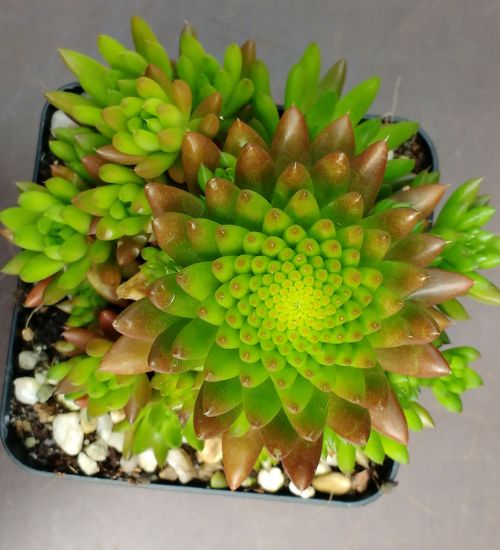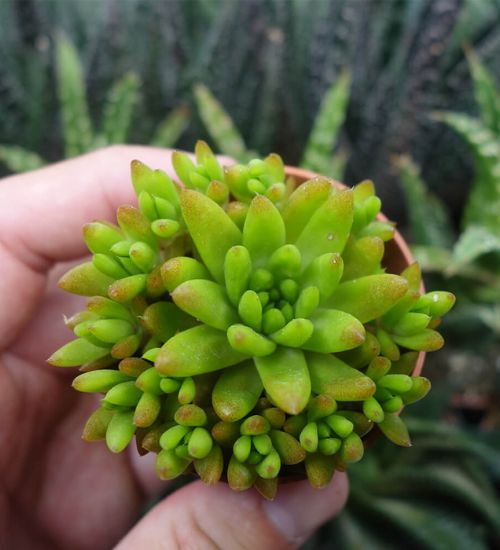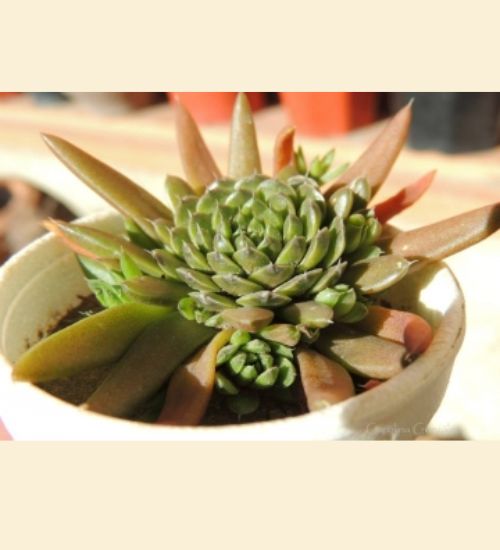Sun: Full sun to light shade
Water: Typical water needs for a succulent
Temperature: Zone 4a from -4°30F to -25° F (-34.4 ° C to -31.7° C) to Zone 9b from 25° F to 30° F (-3.9° C to -1.1° C)
Winter Survival: Cold hardy
Propagation: offsets, seeds
Flower:
Flower Type: white, pink
Toxic: Generally non-toxic to humans and animals
Dormant: winter
Space Requirement: Indoors & Outdoors
Common Problems: Plants may rot if overwatered, pests
Where to buy Orostachys Erubescens?
Basc Care for Orostachys Erubescens
Watering
Watering for Orostachys Erubescens is a simple task. It requires Typical water needs for a succulent.
Regular watering period should be every 2 weeks
Fertilizing
Only feed this succulent during its active growing seasons which means winter. Use the right fertilizer applied in the right amounts. Applying half-strength balanced fertilizer every month or so is recommended for optimal results.
Do not fertilize during winter as the plant is dormant.
Sun & Location Requirements for "Tume - Renge"
Placing "Tume - Renge" in full sun to light shade is key for its growth and health. Look for a spot that gets around 6 hours of direct sunlight each day, but also offers plenty of shade during the hottest parts of the day.
Orostachys Erubescens is one of the most cold hardy succulents available, capable of surviving temperatures down to 0°F. Its thick leaves and stems help retain moisture in its cells and protect it from frigid winter weather. The succulent's attractive foliage adds a touch of cheerfulness to any cold-weather garden. "Tume - Renge" is an ideal choice for areas with freezing temperatures during the winter months.
Any succulents in the group will need a medium space to grow. You can place your pot at your table or window. Since this plant needs more space than mini succulents, you should consider do not plant them together with other succulents/plants.
Orostachys Erubescens also benefits from some indirect light throughout the day as well, so make sure you give it enough space to soak up light without becoming too exposed to heat.
Propagation
Offsets are an easy and reliable way to propagate succulents, like Orostachys Erubescens. With just a few simple steps, you can get a brand-new plant from an existing one.
Propagating Orostachys Erubescens from seeds is a great way to produce new plants without relying on cuttings or divisions. It's important to look for healthy, dark and plump seeds that are slightly sticky when touched. The soil should be pre-mixed with well-draining potting mix, before evenly sowing the seeds and pressing them into the surface. To ensure successful germination, gentle misting of the soil should be done and placed in indirect light.
Toxicity

Orostachys Erubescens is generally non-toxic to humans and animals. However, it is important to be aware that certain parts of the plant may contain toxins which can cause mild skin irritation. It is advised that you keep the plants away from small children or pets, as they may unknowingly ingest them and suffer ill effects.
Pests and Diseases
Orostachys Erubescens can be affected common pests and diseases like most of the other succulents such as mealybugs.
If you do spot any of pest signs, you can treat your succulent using below methods.
- Mealybugs: quarantine, clean infected plants, soapy water.
Besides that, to prevent serious health issues from happening, keep your succulent in a well-ventilated area and check it regularly for any signs of pests or health problems.


